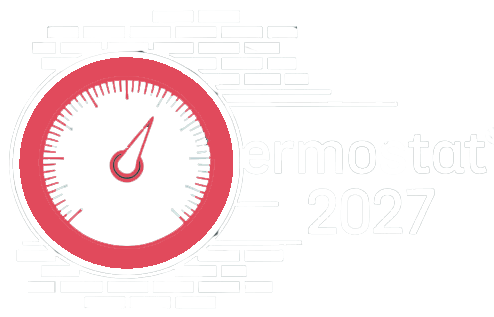Blog
Commercial Electric Smart Thermostat Review

The Commercial Electric Smart Thermostat is white, rectangular with rounded corners, and measures 3.5 by 4.7 by 1.0 inches (HWD). It works with most one- and two-stage heating and cooling HVAC systems, supports auxiliary heat pump control, and comes with a power extender kit for systems without a C-wire. Also included in the box is a comprehensive user guide, mounting hardware, a mounting plate, wiring labels, and a wall plate.

(Credit: Commercial Electric)
The front of the unit has an LCD that shows the current room temperature and has small status indicators for auto, cooling, and heating modes, as well as fan mode, schedule mode, and Wi-Fi.
To the right of the indicators are Fan and Mode buttons, along with up and down arrows to adjust the target temperature. The Mode button lets you toggle between auto, cooling, heating, and off. This button glows red when in heating mode, blue in cooling mode, and white when the thermostat is on but in standby mode. There are three fan settings: auto (comes on when necessary in heating and cooling mode), intermittent (comes on for a set period of time), or on (runs independently of the heating and cooling). There are six presets that you can program for one-touch heating and cooling, a vacation mode setting, and schedule programming for each day of the week.
Similar Products
View The Best Smart Thermostats for 2025
For connectivity, the thermostat uses a Bluetooth radio to pair with your phone and a Wi-Fi radio to connect to your home network. The Smart Thermostat uses the same Hubspace mobile app (available for Android and iOS) as the Feather River Smart Glass Door and the Defiant Touchpad Deadbolt. Once connected, you can control the thermostat from anywhere using the app or with Alexa and Google voice commands. You can use Alexa routines to have the thermostat interact with compatible smart home devices, but it doesn’t support IFTTT applets that provide a wide range of third-party integrations, nor does it work with Apple HomeKit.
The thermostat appears on the home screen of the Hubspace app in a panel that shows the name of the device, the current temperature, and the status (heating, cooling, off). Tap the panel to open a screen with a dial for setting the target temperature and tabs at the top for customizing presets and enabling vacation mode. Other buttons let you enable heating and cooling modes, fan mode and setting, and turn the thermostat on and off. The screen background is color-coded to turn red while in heating mode, blue in cooling mode, and white when the thermostat is off.

(Credit: Commercial Electric/PCMag)
Get Our Best Stories!

Lab Report
By clicking Sign Me Up, you confirm you are 16+ and agree to our Terms of Use and Privacy Policy.
Thanks for signing up!
Your subscription has been confirmed. Keep an eye on your inbox!
At the very bottom of the screen are schedule and settings buttons. The schedule button lets you create heating and cooling schedules for each day of the week. The settings button takes you to a screen where you can configure the thermostat for your specific type of HVAC system, set a safety mode minimum temperature threshold, choose a temperature measurement unit (Fahrenheit, Celsius), configure filter replacement parameters and notifications, edit the thermostat name and location, and set up Wi-Fi.
If you use Alexa, it’s also worth checking out the Amazon Smart Thermostat ($79.99), which adds energy usage reports but does not work with Google Assistant. As a more aesthetic and feature-rich alternative, the Nest Thermostat offers energy usage reports, HVAC system health alerts, IFTTT support, and suggestions that can help lower your bill. If you’re willing to spend a lot more and are looking for extra perks such as air quality monitoring, Apple HomeKit support, remote room sensors, and smart speaker functionality, check out the Ecobee Smart Thermostat Premium ($249.99).












